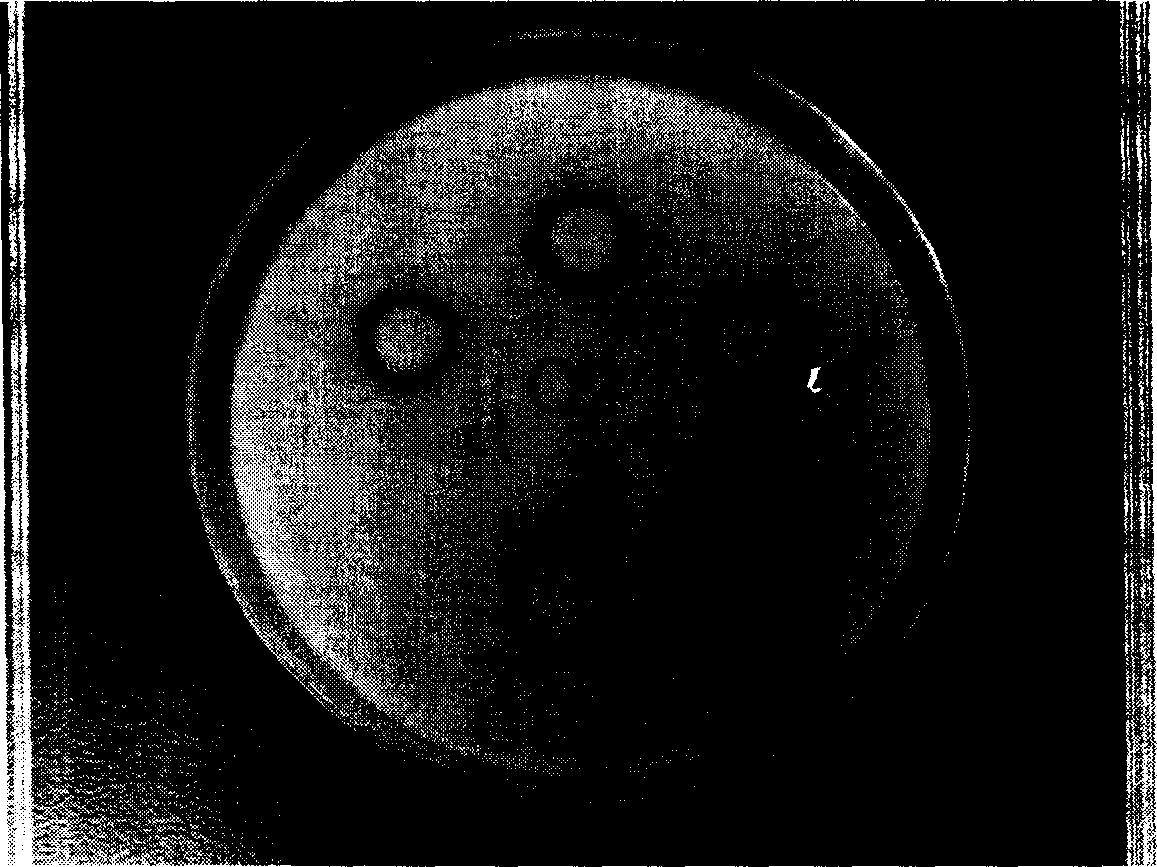Genetic engineering bacterium for degrading chitin absent from chitobiose enzyme
A kind of technology of genetic engineering bacteria and succinase, applied in the field of chitin degrading bacteria
- Summary
- Abstract
- Description
- Claims
- Application Information
AI Technical Summary
Problems solved by technology
Method used
Image
Examples
Embodiment 1
[0013] figure 1 Comparison of the ability of Q2 and CB101 to degrade chitinobiosaccharase substrate 4-MU-chitobioside. Q2 (3 clones on the upper part of the plate) and CB101 (one clone on the bottom of the plate) were spotted on the LB plate and cultured at 37 degrees for 12 hours, then sprayed with the chitinobiosacidase substrate 4-MU-chitobioside, and incubated at 37 degrees in the dark Observations were performed under UV light after 30 minutes.
[0014] Q2 cannot degrade 4-MU-chitobioside, and the colonies do not fluoresce under ultraviolet light excitation; CB101 can effectively degrade 4-MU-chitobioside, and the colonies emit strong fluorescence under ultraviolet light excitation.
Embodiment 2
[0016] The ability and degradation products of Q2 to degrade chitin were analyzed:
[0017] 1. Qualitative Analysis of Chitin Degradation Ability Using Solid Chitin Plates
[0018] Pick single clones of Q2 and wild bacteria CB101 and spread them on a chitin solid plate, culture them at 37 degrees for about 12 hours, and observe the diameter of the transparent circle after degrading chitin. like figure 2 As shown, Q2 retains the ability to degrade chitin efficiently, indicating that although Q2 is mutated to produce chitinobiosaccharase, its ability to degrade chitin has not been reduced.
[0019] figure 2 Qualitative comparison of Q2 and CB101 for degradation of colloidal chitin. Q2 (3 clones on the upper part of the plate) and CB101 (one clone on the bottom of the plate) were spotted on the chitin plate and incubated at 37 degrees for 12 hours to observe the size of the transparent circle after chitin degradation.
Embodiment 3
[0021] Analysis of Degraded Chitin Products
[0022] Q2 was inoculated with basic medium containing 1% colloidal chitin, and the colloidal chitin was completely degraded after the shake flask was cultured at 37 degrees for 24 hours. Take 1ul solution for TLC product analysis, such as image 3 As shown, there are mainly chitinodisaccharides and a small amount of chitinotriose in the fermentation supernatant of Q2; while there are only chitinomonoses in the fermentation product of CB101 wild bacteria. image 3 Thin layer chromatography. G1 is the monosaccharide standard, G2 is the chitobiose standard, Q2 is the fermentation supernatant of strain Q2, and CB101 is the fermentation supernatant of CB101.
[0023] The chitin-degrading genetically engineered bacterium lacking chitinobiosaccharase-Aeromonas caviae, known in Latin civilization as: Aeromonas caviae, was preserved in the China Type Culture Collection Center (Address: Wuhan, Wuhan, China) on December 14, 2003 University...
PUM
 Login to View More
Login to View More Abstract
Description
Claims
Application Information
 Login to View More
Login to View More - R&D
- Intellectual Property
- Life Sciences
- Materials
- Tech Scout
- Unparalleled Data Quality
- Higher Quality Content
- 60% Fewer Hallucinations
Browse by: Latest US Patents, China's latest patents, Technical Efficacy Thesaurus, Application Domain, Technology Topic, Popular Technical Reports.
© 2025 PatSnap. All rights reserved.Legal|Privacy policy|Modern Slavery Act Transparency Statement|Sitemap|About US| Contact US: help@patsnap.com



